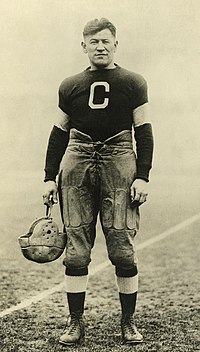
Back Jim Thorpe Afrikaans Jim Thorpe AN جيم ثورب Arabic جيم ثورب ARZ Jim Thorpe AST Jim Thorpe Aymara Cim Torp Azerbaijani جیم تورپ AZB Джим Торп Bashkir Джым Торп Byelorussian
Jim Thorpe | |||||||||||||||
|---|---|---|---|---|---|---|---|---|---|---|---|---|---|---|---|
Wa-Tho-Huk | |||||||||||||||
 Thorpe in 1913 | |||||||||||||||
| Born | James Francis Thorpe May 22 or 28, 1887 Near Prague, Oklahoma, U.S.[a] | ||||||||||||||
| Died | March 28, 1953 (aged 65) Lomita, California, U.S. | ||||||||||||||
| Nationality | Sac and Fox Nation, American | ||||||||||||||
|
American football career | |||||||||||||||
 Thorpe with the Canton Bulldogs, c. 1915 – c. 1920 | |||||||||||||||
| No. 2, 21, 3 | |||||||||||||||
| Position: | Tailback | ||||||||||||||
| Personal information | |||||||||||||||
| Height: | 6 ft 1 in (1.85 m) | ||||||||||||||
| Weight: | 202 lb (92 kg) | ||||||||||||||
| Career information | |||||||||||||||
| High school: | Carlisle Indian Industrial (Carlisle, Pennsylvania) | ||||||||||||||
| College: | Carlisle (1907–1908, 1911–1912) | ||||||||||||||
| Career history | |||||||||||||||
| As a player: | |||||||||||||||
| |||||||||||||||
| As a coach: | |||||||||||||||
| |||||||||||||||
| As an executive: | |||||||||||||||
| |||||||||||||||
| Career highlights and awards | |||||||||||||||
| |||||||||||||||
| Career NFL statistics | |||||||||||||||
| |||||||||||||||
| Head coaching record | |||||||||||||||
| Career: | NFL: 14–25–2 (.366) Ohio League: 32–3–2 (.892) Overall: 46–28–4 (.615) | ||||||||||||||
| Record at Pro Football Reference | |||||||||||||||
|
Baseball career | |||||||||||||||
 Thorpe with the New York Giants | |||||||||||||||
| Outfielder | |||||||||||||||
Batted: Right Threw: Right | |||||||||||||||
| MLB debut | |||||||||||||||
| April 14, 1913, for the New York Giants | |||||||||||||||
| Last MLB appearance | |||||||||||||||
| September 25, 1919, for the Boston Braves | |||||||||||||||
| MLB statistics | |||||||||||||||
| Batting average | .252 | ||||||||||||||
| Home runs | 7 | ||||||||||||||
| RBI | 82 | ||||||||||||||
| Hits | 176 | ||||||||||||||
| Stats at Baseball Reference | |||||||||||||||
| Teams | |||||||||||||||
| 1st President of the NFL | |||||||||||||||
| In office 1920–1921 | |||||||||||||||
| Preceded by | Ralph Hay[b] | ||||||||||||||
| Succeeded by | Joseph Carr | ||||||||||||||
| Olympic medal record | ||
|---|---|---|
| Men's athletics | ||
| Representing the | ||
| 1912 Stockholm | Decathlon | |
| 1912 Stockholm | Pentathlon | |
James Francis Thorpe (Meskwaki: Wa-Tho-Huk, May 22 or 28,[2] 1887 – March 28, 1953) was an American athlete and Olympic gold medalist. A citizen of the Sac and Fox Nation, Thorpe was the first Native American to win a gold medal for the United States in the Olympics. Considered one of the most versatile athletes of modern sports, he won two Olympic gold medals in the 1912 Summer Olympics (one in classic pentathlon and the other in decathlon). He also played football (collegiate and professional), professional baseball, and professional basketball.
He lost his Olympic titles after it was found he had been paid for playing two seasons of semi-professional baseball before competing in the Olympics, thus violating the contemporary amateurism rules. In 1983, 30 years after his death, the International Olympic Committee (IOC) restored his Olympic medals with replicas, after ruling that the decision to strip him of his medals fell outside of the required 30 days. Official IOC records still listed Thorpe as co-champion in decathlon and pentathlon until 2022, when it was decided to restore him as the sole champion in both events.
Thorpe grew up in the Sac and Fox Nation in Indian Territory (what is now the U.S. state of Oklahoma). As a youth, he attended Carlisle Indian Industrial School in Carlisle, Pennsylvania, where he was a two-time All-American for the school's football team under coach Pop Warner. After his Olympic success in 1912, which included a record score in the decathlon, he added a victory in the All-Around Championship of the Amateur Athletic Union. Later in 1913, Thorpe signed with the New York Giants, and he played six seasons in Major League Baseball between 1913 and 1919. Thorpe joined the Canton Bulldogs American football team in 1915, helping them win three professional championships. He later played for six teams in the National Football League (NFL). He played as part of several all-American Indian teams throughout his career, and barnstormed as a professional basketball player with a team composed entirely of American Indians.
From 1920 to 1921, Thorpe was nominally the first president of the American Professional Football Association, which became the NFL in 1922. He played professional sports until age 41, the end of his sports career coinciding with the start of the Great Depression. He struggled to earn a living after that, working several odd jobs. He suffered from alcoholism, and lived his last years in failing health and poverty. He was married three times and had eight children, including Grace Thorpe, an environmentalist and Native rights activist, before suffering from heart failure and dying in 1953.
Thorpe has received numerous accolades for his athletic accomplishments. The Associated Press ranked him as the "greatest athlete" from the first 50 years of the 20th century, and the Pro Football Hall of Fame inducted him as part of its inaugural class in 1963. The town of Jim Thorpe, Pennsylvania, was named in his honor. It has a monument site that contains his remains, which were the subject of legal action. Thorpe appeared in several films and was portrayed by Burt Lancaster in the 1951 film Jim Thorpe – All-American.
Cite error: There are <ref group=lower-alpha> tags or {{efn}} templates on this page, but the references will not show without a {{reflist|group=lower-alpha}} template or {{notelist}} template (see the help page).